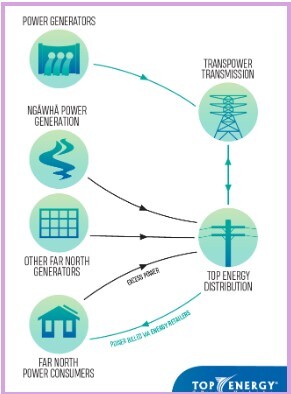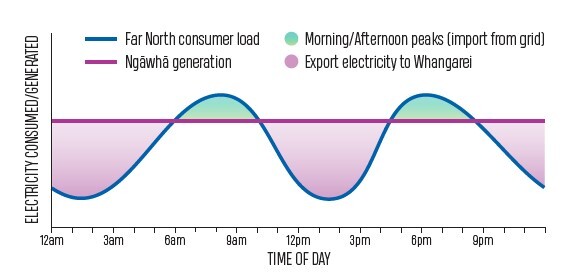Can Ngāwhā operate in "Island Mode" in the Far North?
We often get asked if Ngāwhā can continue to supply power independently in case of a grid emergency on Transpower’s transmission network (the national grid). The answer is no, and here's why.
An Integrated Electricity System
Ngāwhā, the Top Energy network, and the Transpower network are part of an integrated electricity system that works together to ensure stable and reliable power supply. Ngāwhā is not permitted by Transpower (as the System Operator) to act independently.
Ngāwhā generates enough electricity to supply 125% of the Far North's electricity needs 95% of the year, providing a strong local supply.
However, during peak demand, especially on winter evenings, we still need to import some power from Transpower’s transmission network.

Ngāwhā and the National Grid
Ngāwhā is not designed to operate in ‘island mode’ for the Far North but plays a crucial role in the national transmission network, helping to maintain the stability of New Zealand’s energy supply.
In a grid emergency where power supply into Northland is interrupted, Ngāwhā will safely shut down as designed.
Ngāwhā is a baseload generator. This means it continuously generates power at maximum capacity to produce a steady and reliable amount of electricity to meet the minimum demand of the network at all times.
When the Far North's demand is lower than Ngāwhā's generation, the excess electricity is exported to Northpower’s network through the Transpower transmission line from Kaikohe to Maungatapere over 95% of the time.
The exported power helps manage constraints and reduces reliance on the Transpower transmission network further south, aiding the overall balance of electricity load and generation.
The diagram below illustrates the fluctuations in electricity consumption in the Far North compared to Ngāwhā’s steady output.

What Happens During a Full Loss of the Transpower Transmission Network?
In the event of a complete loss of power into Northland, Ngāwhā cannot adjust its output and will instantly and automatically shut down to prevent damage to the generation plant and consumer appliances.
Transpower will declare a grid emergency and manage the situation.
As the System Operator, Transpower will set limits on electricity usage on Top Energy’s network and other impacted electricity lines companies, like Northpower and Vector.
This might involve asking customers to conserve power, implementing hot water load management through ripple control, or, in extreme cases, initiating rolling outages to restore balance and prevent uncontrolled widespread outages.
During such events, power from generators like Ngāwhā is included in the available supply and distributed among affected users.
Once Transpower reconnects the grid, Ngāwhā will resume operation, restoring supply to the Far North and supporting the broader Northland area. Top Energy may also use its northern generators to boost supply during shortfalls, though they are insufficient to support the full network.
Key Causes of Grid Emergencies
Grid emergencies occur when the balance between electricity supply and demand is disrupted, posing a risk to system stability and reliability, potentially leading to outages or blackouts. Key causes include:
Supply Shortfalls
- Generation Failures: Power plants might fail due to mechanical issues, fuel shortages, or environmental conditions.
Demand Surges
- Extreme Weather: Hot weather increases air conditioning use, while cold weather spikes heating use.
- Unexpected Load Increases: Sudden industrial activity or large-scale energy demands can cause unexpected spikes in electricity usage.
Transmission Failures
- Equipment Malfunctions: Faults in transmission lines, transformers, or substations can disrupt power flow.
- Weather-Related Damage: Storms, floods, and other extreme weather events can damage infrastructure.
